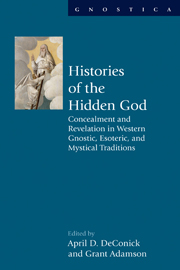 Histories of the Hidden God
Histories of the Hidden God from Part I - Concealment of the Hidden God
Amun, the name of the Egyptian god, means hidden, and the utterly transcendent deity in Eugnostos is described likewise. This could be attributed immediately to coincidence if it were not for several other points of interest in the text. First, the theogony in Eugnostos arguably once featured the same number of single and paired gods as found in the Khonsu Cosmogony, an Egyptian monumental source from the Ptolemaic period. Second, in Eugnostos these gods are referred to by Hermetic terms of generation, namely unbegotten, self-begotten, begotten and so on. Third, the cosmos that the gods in Eugnostos produce is manifestly that of the decans who govern the thirty-six weeks of the year in the Egyptian calendar.
That such cosmological and calendrical assumptions are made in Eugnostos is enough to wonder to what extent the text may be neither Christian nor Jewish: whereas Egyptians kept a ten-day week marked by the rising of a decan, Jews and Christians observed a seven-day week in accordance with the Decalogue. This is not to deny the influence of Jewish literature on the text at some stage of composition; indeed, the author of this didactic letter and for whom it is named could have been a Hellenized Jew living in Egypt, such as one of Philo's extreme allegorizers unconcerned with the Sabbath. But as for the early church, in Roelof van den Broek's words, “I am unable to see any distinct and indisputable Christian influence.”
To save this book to your Kindle, first ensure no-reply@cambridge.org is added to your Approved Personal Document E-mail List under your Personal Document Settings on the Manage Your Content and Devices page of your Amazon account. Then enter the ‘name’ part of your Kindle email address below. Find out more about saving to your Kindle.
Note you can select to save to either the @free.kindle.com or @kindle.com variations. ‘@free.kindle.com’ emails are free but can only be saved to your device when it is connected to wi-fi. ‘@kindle.com’ emails can be delivered even when you are not connected to wi-fi, but note that service fees apply.
Find out more about the Kindle Personal Document Service.
To save content items to your account, please confirm that you agree to abide by our usage policies. If this is the first time you use this feature, you will be asked to authorise Cambridge Core to connect with your account. Find out more about saving content to Dropbox.
To save content items to your account, please confirm that you agree to abide by our usage policies. If this is the first time you use this feature, you will be asked to authorise Cambridge Core to connect with your account. Find out more about saving content to Google Drive.